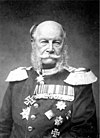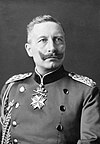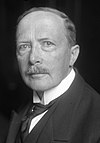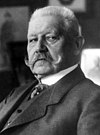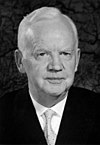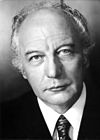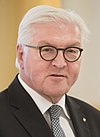List of heads of state of Germany
This is a list of heads of state of Germany .
History
Germany was ruled by monarchs from the beginning of division of the Frankish Empire in August 843 to the dissolution of the Holy Roman Empire in August 1806 .[ 1] [ 2] [ 3] Confederation of the Rhine dominated by Napoleon (1806-1913) and the German Confederation created by the Congress of Vienna (1814-1866). The Prussian-led North German Confederation (1866-1871) subsequently morphed into a modern nation state, the German Reich , which was ruled by emperors from 1871 to the collapse of all German monarchies in 1918.
The President of Germany replaced the monarch in 1919. Chancellor Adolf Hitler assumed the duties of head of state as Führer and Chancellor from 1934 until his suicide in April 1945. In 1949, Germany was divided into two states. The Federal President , head of state of West Germany, became head of state for all of Germany following German reunification in 1990.
Carolingians
Conradine dynasty
Ottonian dynasty
The title "King of the Romans", used under the Holy Roman Empire, is (from this point onwards) considered equivalent to King of Germany. A king was chosen by the German electors and would then proceed to Rome to be crowned emperor by the pope.
Image
Name
House
King
Emperor
Ended
Notes
Otto I the Great (Otto I. der Große)
Ottonian
7 August 936
2 February 962
7 May 973
Son of Henry I; first king crowned in Aachen Cathedral since Lothair I ; crowned as Otto by the grace of God King;[ 4] Holy Roman Emperor in 961
Otto II the Red (Otto II.)
Ottonian
26 May 961
25 December 967
7 December 983
Son of Otto I;[ 4] Emperor in his father's lifetime
Otto III (Otto III.)
Ottonian
25 December 983
21 May 996
21 January 1002
Son of Otto II; Otto by the grace of God King[ 4]
Henry II (Heinrich II. der Heilige)
Ottonian
7 June 1002
26 April 1014
13 July 1024
Great-grandson of Henry I
Salian dynasty
Image
Name
House
King
Emperor
Ended
Notes
Conrad II (Konrad II.)
Salian (Frankish)
8 September 1024
26 March 1027
4 June 1039
Great-great-grandson of Otto I
Henry III (Heinrich III.)
Salian
14 April 1028
25 December 1046
5 October 1056
Son of Conrad II;[ 4]
Henry IV (Heinrich IV.)
Salian
17 July 1054
21 March 1084
31 December 1105
Son of Henry III;
Rudolf of Rheinfelden (Rudolf von Rheinfelden)
Rheinfeld
15 March 1077
—
15 October 1080
Rival king to Henry IV
Hermann of Salm (Hermann von Luxemburg, Graf von Salm)
Salm
6 August 1081
—
28 September 1088
Rival king to Henry IV
Conrad (Konrad) Salian
30 May 1087
—
27 July 1101
Son of Henry IV;
Henry V (Heinrich V.)
Salian
6 January 1099
13 April 1111
23 May 1125
Son of Henry IV;
Supplinburger dynasty
Image
Name
House
King
Emperor
Ended
Notes
Lothair III (Lothar III.)
Supplinburger
30 August 1125
4 June 1133
4 December 1137
He was Lothair II of Germany, but Lothair III of Italy
Hohenstaufen and Welf dynasties
Image
Name
House
King
Emperor
Ended
Notes
Conrad III (Konrad III.)
Hohenstaufen
7 March 1138
—
15 February 1152
Grandson of Henry IV (through his mother);
Henry Berengar (Heinrich (VI.))
Hohenstaufen
30 March 1147
—
August? 1150
Son of Conrad III;
Frederick I Barbarossa (Friedrich I. Barbarossa)
Hohenstaufen
4 March 1152
18 June 1155
10 June 1190
Nephew of Conrad III
Henry VI (Heinrich VI.)
Hohenstaufen
15 August 1169
14 April 1191
28 September 1197
Son of Frederick I;
Frederick II (Friedrich II.)
Hohenstaufen
1197
—
1197
Son of Henry VI;
Philip of Swabia (Philipp von Schwaben)
Hohenstaufen
6 March 1198
—
21 August 1208
Son of Frederick I; rival king to Otto IV
Otto IV (Otto IV. von Braunschweig)
Welf
29 March 1198
4 October 1209
5 July 1215
Rival king to Philip of Swabia; later opposed by Frederick II ; deposed, 1215; died 19 May 1218
Frederick II (Friedrich II.)
Hohenstaufen
5 December 1212
22 November 1220
26 December 1250
Son of Henry VI;
Henry (Heinrich (VII.))
Hohenstaufen
23 April 1220
—
15 August 1235
Son of Frederick II;
Conrad IV (Konrad IV.)
Hohenstaufen
May 1237
—
1 May 1254
Son of Frederick II;
Interregnum
Image
Coat of arms
Name
House
King
Emperor
Ended
Notes
Henry Raspe (Heinrich Raspe)
Thuringia
22 May 1246
—
16 February 1247
Rival King to Frederick II and great-great-great grandson of Henry IV
William of Holland (Wilhelm von Holland)
Holland
3 October 1247
—
28 January 1256
Rival King to Frederick II and Conrad IV, 1247–1254
Richard of Cornwall (Richard von Cornwall)
Plantagenet
13 January 1257
—
2 April 1272
Brother-in-law of Frederick II; rival king to Alfonso of Castile; held no real authority.
Alfonso of Castile (Alfons von Kastilien)
House of Ivrea
1 April 1257
—
1275
Grandson of Philip; rival king to Richard of Cornwall; held no authority; later opposed by Rudolf I; relinquished claims 1275, died 1284
Changing dynasties
Habsburg
Image
Coat of arms
Name
House
King
Emperor
Ended
Notes
Albert II (Albrecht II.)
Habsburg
18 March 1438
—
27 October 1439
4th in descent from Albert I;
Frederick III (Friedrich III.)
Habsburg
2 February 1440
16 March 1452
19 August 1493
4th in descent from Albert I; 2nd cousin of Albert II
Maximilian I (Maximilian I.)
Habsburg
16 February 1486
4 February 1508
12 January 1519
Son of Frederick III; King of Germany under his father, 1486–1493; assumed the title "Elected Emperor" in 1508 with the pope's approval
Charles V (Karl V.)
Habsburg
28 June 1519
28 June 1519
3 August 1556
Grandson of Maximilian I; died 21 September 1558
Ferdinand I (Ferdinand I.)
Habsburg
5 January 1531
14 March 1558
25 July 1564
Grandson of Maximilian I; brother of Charles V; King of Germany under his brother Charles V 1531–1556; last king to be crowned in Aachen Cathedral . Emperor
Maximilian II (Maximilian II.)
Habsburg
22 November 1562
25 July 1564
12 October 1576
Son of Ferdinand I;
Rudolf II (Rudolf II.)
Habsburg
27 October 1575
2 November 1576
20 January 1612
Son of Maximilian II;
Matthias (Matthias)
Habsburg
13 June 1612
13 June 1612
20 March 1619
Son of Maximilian II
Ferdinand II (Ferdinand II.)
Habsburg
28 August 1619
28 August 1619
15 February 1637
Grandson of Ferdinand I
Ferdinand III (Ferdinand III.)
Habsburg
22 December 1636
15 February 1637
2 April 1657
Son of Ferdinand II;
Ferdinand IV (Ferdinand IV.)
Habsburg
31 May 1653
—
9 July 1654
Son of Ferdinand III;
Leopold I (Leopold I.)
Habsburg
18 July 1658
18 July 1658
5 May 1705
Son of Ferdinand III
Joseph I (Joseph I.)
Habsburg
23 January 1690
5 May 1705
17 April 1711
Son of Leopold I; King of Germany under his father 1690–1705
Charles VI (Karl VI.)
Habsburg
27 October 1711
27 October 1711
20 October 1740
Son of Leopold I
Wittelsbach
Image
Coat of arms
Name
House
King
Emperor
Ended
Notes
Charles VII (Karl VII.)
Wittelsbach
14 January 1742
14 January 1742
20 January 1745
Great-great-grandson of Ferdinand II; Husband of Maria Amalia , daughter of Joseph I
Habsburg-Lorraine
Image
Coat of arms
Name
House
King
Emperor
Ended
Notes
Francis I (Franz I.)
Lorraine
13 September 1745
13 September 1745
18 August 1765
Great-grandson of Ferdinand III; Husband of Maria Theresa , daughter of Charles VI
Joseph II (Joseph II.)
Habsburg-Lorraine
27 March 1764
18 August 1765
20 February 1790
Son of Francis I and Maria Theresa; King of Germany under his father 1764–1765
Leopold II (Leopold II.)
Habsburg-Lorraine
30 September 1790
30 September 1790
1 March 1792
Son of Francis I and Maria Theresa
Francis II (Franz II.)
Habsburg-Lorraine
7 July 1792
7 July 1792
6 August 1806
Son of Leopold II; Dissolved the Holy Roman Empire; also Emperor of Austria 1804–1835; President of the German Confederation (1815-1835), died 1835
† denotes people who died in office.
† denotes people who died in office.
Portrait
Bundespräsident Took office
Left office
Time in office
Party
Election
Heuss, Theodor Theodor Heuss (1884–1963) 13 September 1949 12 September 1959 FDP 1949 1954 Lübke, Heinrich Heinrich Lübke (1894–1972) 13 September 1959 30 June 1969(resigned ) CDU 1959 1964 Heinemann, Gustav Gustav Heinemann (1899–1976) 1 July 1969 30 June 1974 SPD 1969 Scheel, Walter Walter Scheel (1919–2016) 1 July 1974 30 June 1979 FDP 1974 Carstens, Karl Karl Carstens (1914–1992) 1 July 1979 30 June 1984 CDU 1979 Weizsäcker, Richard Richard von Weizsäcker (1920–2015) 1 July 1984 30 June 1994 CDU 1984 1989 Herzog, Roman Roman Herzog (1934–2017) 1 July 1994 30 June 1999 CDU 1994 Rau, Johannes Johannes Rau (1931–2006) 1 July 1999 30 June 2004 SPD 1999 Köhler, Horst Horst Köhler (born 1943) 1 July 2004 31 May 2010(resigned ) CDU 2004 2009 Böhrnsen, Jens Jens Böhrnsen (born 1949) Acting [ c] 31 May 2010 30 June 2010 SPD – Wulff, Christian Christian Wulff (born 1959) 30 June 2010 17 February 2012(resigned ) CDU 2010 Seehofer, Horst Horst Seehofer (born 1949) Acting [ c] 17 February 2012 18 March 2012 CSU – Gauck, Joachim Joachim Gauck (born 1940) 18 March 2012 18 March 2017 Independent 2012 Steinmeier, Frank-Walter Frank-Walter Steinmeier (born 1956) 18 March 2017 Incumbent SPD 2017 2022
† denotes people who died in office.
Portrait
Name
Took office
Left office
Time in office
Party
President of the Republic Präsident der Republik Pieck, Wilhelm Wilhelm Pieck (1876–1960) 11 October 1949 7 September 1960 † SED Dieckmann, Johannes Johannes Dieckmann (1893–1969) Acting [ d] 7 September 1960 12 September 1960 LDPD
Chairman of the State Council Vorsitzender des Staatsrats Ulbricht, Walter Walter Ulbricht (1893–1973) 12 September 1960 1 August 1973 † SED Ebert, Friedrich Friedrich Ebert Jr. (1894–1979) Acting [ e] 1 August 1973 3 October 1973 SED Stoph, Willi Willi Stoph (1914–1999) 3 October 1973 29 October 1976 SED Honecker, Erich Erich Honecker (1912–1994) 29 October 1976 18 October 1989(resigned ) SED Krenz, Egon Egon Krenz (born 1937) 18 October 1989 6 December 1989(resigned ) SED Gerlach, Manfred Manfred Gerlach (1928–2011) 6 December 1989 5 April 1990(office abolished ) LDPD
President of the People's Chamber Präsident der Volkskammer Bergmann-Pohl, Sabine Sabine Bergmann-Pohl (born 1946) 5 April 1990 2 October 1990(East Germany joined Federal Republic CDU
Styles of the Heads of State
Unified state (1871 to 1945) East and West Germany (1949 to 1990) Unified state (1990 to present)
Notes
References
^ Gowers, Bernard (December 2011). "III The Central Middle Ages (900-1200)". Annual Bulletin of Historical Literature . 95 (1): 12– 21. doi :10.1111/j.1467-8314.2011.01248.x . ISSN 0066-3832 . ^ Arnold, Benjamin (1997). Medieval Germany 500–1300 . doi :10.1007/978-1-349-25677-8 . ISBN 978-0-333-61092-3 ^ The bee and the eagle: Napoleonic France and the end of the Holy Roman Empire, 1806 . Forrest, Alan I., Wilson, Peter H. (Peter Hamish). Basingstoke [England]: Palgrave Macmillan. 2009. ISBN 978-0-230-00893-9 OCLC 227575082 .{{cite book }}: CS1 maint: others (link )^ a b c d Medieval Europeans: studies in ethnic identity and national perspectives in medieval Europe By Alfred P. Smyth, Palgrave Macmillan (1998), p. 64^ a b Ernst Rudolf Huber: Deutsche Verfassungsgeschichte seit 1789 . Vol. I: Reform und Restauration 1789 bis 1830. 2nd edition, Kohlhammer Verlag , Stuttgart [et.al.] 1967, p. 589.
^ Ernst Rudolf Huber: Deutsche Verfassungsgeschichte seit 1789 . Vol. I: Reform und Restauration 1789 bis 1830. 2nd edition, Kohlhammer Verlag , Stuttgart [et.al.] 1967, p. 625–627, 808.
^ Elected Emperor of the Germans by the Frankfurt National Assembly on 28 March 1849, but refused the crown on 28 April 1849.
Manfred Botzenhart: Deutscher Parlamentarismus in der Revolutionszeit 1848–1850 . Droste Verlag, Düsseldorf 1977, pp. 697/698.
^ Anlage II: Additional-Akte zu dem Entwurf der Verfassung des Deutschen Reichs . In: Thüringer Landtag Erfurt (ed.): 150 Jahre Erfurter Unionsparlament (1850–2000) (= Schriften zur Geschichte des Parlamentarismus in Thüringen. H. 15) Wartburg Verlag, Weimar 2000, ISBN 3-86160-515-5 , S. 27–44, here pp. 185–187.^ a b Ernst Rudolf Huber: Deutsche Verfassungsgeschichte seit 1789. Band III: Bismarck und das Reich. 3. Auflage, Kohlhammer Verlag , Stuttgart 1988, S. 750/751.
^ His abdication was announced by the Chancellor on 9 November, and the Emperor went into exile in the Netherlands. He did not formally abdicate until 28 November.











































































































